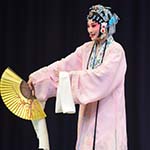
Chinese Opera In Delhi
Delhi recently witnessed something never before seen in India, Chinese Opera. Opera is a tradition that has been followed and continues till date in its original as well as in its modern form. Theatre as an art form has its own belonging and strong roots in our country however yesterday in the Siri Fort Auditorium, Delhi experienced something like never before. It witnessed the beautiful blend of Opera and Theatre. Bravia Sadir Theatre Festival premiered a 600 year old art form of China, the Kunqu Opera.

Kunqu Opera Performance at Sirifort Auditorium, Delhi
With the aim to promote arts and culture between the two neighboring countries, Ms Swati Bhise, an acclaimed Bharatnatyam Dancer, Choreographer and Artistic Director of Bravia Sadir Theatre Festival said on the occasion, “It took us three years to get this project here. I saw the performance some 15 years back in the American center and found it to be breath taking. My Guru, Ms. Sonal Mansingh always told me to take up a project which has never been done before, so I decided to get it here. It is a beautiful Opera that is being performed since the time of William Shakespeare and it has symbolic meaning and stylized mudra. Here, we are going to witness the story of The Peony Pavilion that runs on the theme of Romeo- Juliet, Heer-Ranjha. It is not just the China’s culture that we are bringing here but also making people realize that it is quite similar to the cultural and traditional dance forms we have been witnessing since forever.”

The Peony Pavilion, written by Tang Xianzu in Ming Dynasty and performed for the first time in 1598
A sophisticated, stylized and lyrical opera, The Peony Pavilion is a complicated love-story which was set in the last days of the Southern Song Dynasty, which lasted from 1127 to 1279 AD. Talking about the art-from, Cao Ying, Vice President of China Northern Kunqu Opera Theatre, in conversation with One World News said, “Kunqu has about 600 years worth of history and it is like a mother to other art forms and other traditional forms of Opera. Whether it is the poetry of Kunqu or the way the music is formed and the way it is performed on the stage, everything is codified. The play that we are presenting here is a classical play which traces its origin some 400 years ago.

A beautiful experience for Dilliwala’s on Friday.
Continuing, Mr. Ying said, “Even though other forms of art are picking up in China, Kunqu has managed to keep itself alive. In Kunqu, an artist sings and dances together and using the same art forms we try to portray a story to the audience. If someone wants to be a Kunqu artist, he or she would have to take up professional training from the age of 10 and it is a lifelong commitment. It takes 10 years for someone to get as much as training to be able to perform on stage. Even in this time, Kunqu is becoming an art which is gaining popularity amongst the youngsters. It is our first performance and we are very happy and excited about it.”

Zhang Yuanyuan and Shao Zheng performing at Sirifot Auditorium
The guest of Honor, Padma Vibhushan Sonal Mansingh on the occasion said, “Swati has been telling me about this and I knew it is going to be very beautiful, fun and an experience to remember. I am thankful to her to do such mad things which I hope she never stops. In this madness there is a method to share the beauty and joy of great art, which doesn’t involve any technological instruments but through an oral experience that people need. So, I congratulate Swati and the artists for being here.”

First part of the act in The Peony Pavilion
The English translation, which captured the essence of love story, was displayed on a LED screen in the auditorium. The play was staged by 18 performers, all from mainland China. It was translated by Joanna Lee, an American-Chinese who has spent a lifetime working in Operas.
Picture Credits : A. Kameshwari
Have a news story, an interesting write-up or simply a suggestion? Write to us at
info@oneworldnews.com







